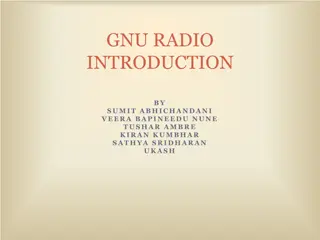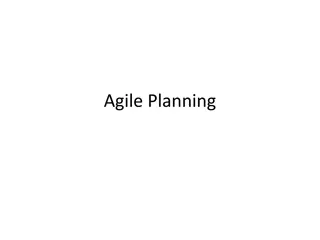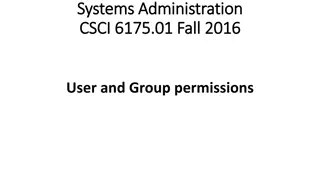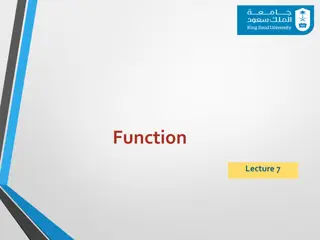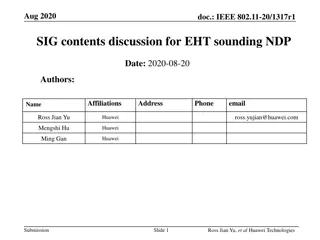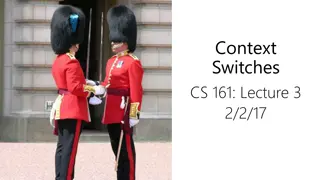
User-Defined Data Types in C: Structures, Enums, and Unions
Explore the fundamentals of user-defined data types in C, covering structures, enums, unions, and more. Learn how to define, declare, and initialize variables, and understand the concepts of enumerated constants. Dive into the syntax and examples of creating structures to organize related variables effectively.
Download Presentation

Please find below an Image/Link to download the presentation.
The content on the website is provided AS IS for your information and personal use only. It may not be sold, licensed, or shared on other websites without obtaining consent from the author. If you encounter any issues during the download, it is possible that the publisher has removed the file from their server.
You are allowed to download the files provided on this website for personal or commercial use, subject to the condition that they are used lawfully. All files are the property of their respective owners.
The content on the website is provided AS IS for your information and personal use only. It may not be sold, licensed, or shared on other websites without obtaining consent from the author.
E N D
Presentation Transcript
CSC215 Lecture User-Defined Data Types
Outline Enumerated Structures Union Bitfield typedef keyword definition , declaration of variables definition , declaration of variables , members access , initialization nested structures , size of structure pointer to structure , array of structure definition , declaration of variables , size of union
Enumerated Constants An enumeration is a user-defined data type that consists of integral constants. Sytnax: enum <type_name> {<id1>[=<val1], <id2>[=<val2>], ..., <idn>[=<valn>]}; Example: enum suit { club = 0, diamonds = 10, hearts = 20, spades = 3, }; Values can be omitted Assigned automatically starting from 0, or from last assigned value, and increasing enum week {sunday,monday,tuesday,wednesday,thursday,friday,saturday };
Enumerated Constants enum TYPE {A = 1, B = 10, C = 100, D = 1000}; printf("%d %d %d %d\n", A, B, C ,D); 1 10 100 1000 enum TYPE {A, B, C , D}; printf("%d %d %d %d\n", A, B, C ,D); 0 1 2 3 enum TYPE {A, B = 10, C, D = 1000}; printf("%d %d %d %d\n", A, B, C ,D); 0 10 11 1000 enum TYPE {A = 12, B = 10, C, D}; printf("%d %d %d %d\n", A, B, C ,D); 12 10 11 12 enum DoW {sunday,monday,tuesday,wednesday,thursday,friday,saturday}; enum DoW d1, d2=tuesday; enum DoW {sunday,monday,tuesday,wednesday,thursday,friday,saturday} d1, d2=tuesday;
Structure A Structure is a collection of related variables: possibly of different types, unlike arrays grouped together under a single name A structure type in C is called struct A Structure holds data that belongs together Examples: Student record: student id, name, major, gender, .. Bank account: account number, name, balance, .. Date: year, month, day Point: x, y struct defines a new datatype.
struct Definition Syntax: struct <struct_tag>{ [<struct_tag>]{ <type> <identifier_list>; <identifier_list>; <type> <identifier_list>; <identifier_list>; struct <type> <type> }; struct point{ int x ; int y ; }; struct Student{ int st_id; char fname[100]; char lname[100]; int age; } }<variable_list>; Examples
Declaration of struct Variable Declaration of a variable of struct type: struct <struct_type> <identifier_list>; Example1 struct studentRec { int student_idno; char student_name[20]; int age; } s1, s2; Example2 struct s1 { char c; int i; } u ; struct s2 { char c; int i; } v ; struct s3 { char c; int i; } x ; struct s3 y ; The types of u , v and x are all different, but the types of x and y are the same. struct studentRec { int student_idno; char student_name[20]; int age; }; struct studentRec s1, s2;
struct Members Individual components of a struct type are called members (or fields) can be of different types (simple, array or struct). Complex data structures can be formed by defining arrays of structs. Members of a struct type variable are accessed with direct access operator (.) Syntax: <struct-variable>.<member_name>; Example: strcpy(s1.student_name, "Mohamed Ali"); s1.studentid = 43321313; s1.age = 20; printf("The student name is %s", s1.student_name); struct point ptA;
struct Variable Initialization Initialization is done by specifying values of every member. struct point ptA={10,20}; Assignment operator copies every member of the structure be careful with pointers Cannot use == to compare two structure variables A variable of a structure type can be also initialized by any the following methods: Example: struct date { int day, month , year ; } birth_date = {31 , 12 , 1988}; struct date newyear={1, 1};
Nested Structures Let s consider the structures: We can define the Client inside the BankAccount struct BankAccount{ char name[21]; int accNum[20]; double balance; struct{ char name[21]; char gender; int age; char address[21]; } aHolder; } ba; ba.aHolder.age = 35; struct Client{ char name[21]; char gender; int age; char address[21]; }; struct BankAccount{ char name[21]; int accNum[20]; double balance; struct Client aHolder; } ba; ba.aHolder.age = 35;
Pointer to Structure Created the same way we create a pointer to any simple data type. struct date *cDatePtr, cDate; We can make cDatePtr point to cDate by: cDatePtr = &cDate The pointer variable cDatePtr can now be used to access the member variables of date using the dot operator as: (*cDatePtr).year (*cDatePtr).month (*cDatePtr).day The parentheses are necessary! the precedence of the dot operator . is higher than that of the dereferencing operator *
Pointer to Structure Pointers are so commonly used with structures. C provides a special operator -> called the structure pointer or arrow operator or the indirect access operator, for accessing members of a structure variable pointed by a pointer. Syntax: <pointer-name> -> <member-name> Examples: cDatePtr-> year cDatePtr-> month cDatePtr-> day You cannot declare a member x of type struct T inside struct T But you can declare a member x of type structT* inside struct T (*cDatePtr).year (*cDatePtr).month (*cDatePtr).day
Pointer to Structure Example #include <stdio.h> #include <math.h> struct Point{ int x; int y; }; float distance(struct Point p1, struct Point p2){ return sqrt((p1.x-p2.x)*(p1.x-p2.x)+ (p1.y-p2.y)*(p1.y-p2.y)); } int main(){ struct Point pp = {3,7}; struct Point ppp = {-5,2}; printf("%.2f\n", distance(pp, ppp)); return 0; }
Pointer to Structure Example #include <stdio.h> #include <math.h> struct Point{ int x; int y; }; float distance(struct Point *p1, struct Point *p2){ return sqrt((p1->x-p2->x)*(p1->x-p2->x)+ (p1->y-p2->y)*(p1->y-p2->y)); } int main(){ struct Point pp = {3,7}; struct Point ppp = {-5,2}; printf("%.2f\n", distance(&pp, &ppp)); return 0; }
Alignment of Structures: Size of a structure: size of a structure is greater than or equal to the sum of the sizes of its members. Why: greater than or ? Alignment Data must be aligned at specific offsets in memory In a way that data does not cross across boundaries When computer reads/writes from/to memory address Data are read/written as whole words A word size is determined by platform: Ex. 4 bytes in 32-bit systems Why alignment Self-alignment speeds up memory access to fetch/write typed data Allows memory items to be retrieved in fewer memory accesses Simplifies addressing codes: Scaled index addressing mode works better
Array of Structures Can create an array of structures Example: struct studentRec { int student_idno; char *student_name; int age; }; struct studentRec studentRecords[500]; studentRecords is an array containing 500 elements of the type struct studentRec. Member variable inside studentRecords can be accessed using array subscript and dot operator: studentRecords[0].student_name = "Mohammad";
Example #include <stdio.h> struct Employee {/* declare a global structure type */ int idNum; double payRate; double hours; }; double calcNet(struct Employee *); /* function prototype */ int main() { struct Employee emp = {6787, 8.93, 40.5}; double netPay; netPay = calcNet(&emp); /* pass an address*/ printf("The net pay for employee %d is $%6.2f\n", emp.idNum, netPay); return 0; } /* pt is a pointer to a structure of Employee type */ double calcNet(struct Employee *pt) { return(pt->payRate * pt->hours); }
Union A variable that may hold objects of different types/sizes in same memory location union data{ int idata; float fdata; char* sdata; } d1, d2, d3; Size of union variable is equal to size of its largest element. Compiler does not test if the data is being read in the correct format. union data d; d.idata=10; float f=d.fdata; /* will give junk */ A common solution is to maintain a separate variable. enum dtype {INT,FLOAT,CHAR}; struct variant { union data d; enum dtype t; }; d1.idata = 10; d2.fdata = 3.14F ; d3.sdata = "hello world" ;
BitField A set of adjacent bits within a single word . Example: struct flag{ unsigned int is_color:1; unsigned int has_sound:1; unsigned int is_ntsc:1; } ; Number after the colons specifies the width in bits. Each variables should be declared as unsigned int Bit fields
typedef Keyword Gives a type a new name typedef unsigned char BYTE; BYTE b1, b2; Can be used to give a name to user defined data types as well struct Books { char title[50]; char author[50]; char subject[100]; int book_id; }; typedef struct Books Book; typedef struct { char title[50]; char author[50]; char subject[100]; int book_id; } Book; Book b1, b2; Book b1, b2;
Example1: Polygon (polygon.h) #ifndef POLYGON #define POLYGON #include <stdio.h> #include <stdlib.h> #include <math.h> typedef struct { int x; int y; } Point; typedef struct{ Point* vertices; int count; } Polygon; float distance(Point*, Point*); Polygon* getPG(); int isParallelogram(Polygon*); #endif
Example1: Polygon (polygon.c) #include "polygon.h" Polygon* getPG(){ Polygon* pg; Point* p; int i=0; pg = (Polygon*)calloc(1, sizeof(Polygon)); printf("Enter number of points:"); scanf("%d", &(pg->count)); p=pg->vertices=(Point*)calloc(pg->count, sizeof(Point)); if (!p) return NULL; while (p < (pg->vertices)+(pg->count)){ printf("Enter x for point p%d:", i+1); scanf("%d", &(p->x)); printf("Enter y for point p%d:", i+++1); scanf("%d", &(p->y)); p++; } return pg; }
Example1: Polygon (polygon.c) float distance(Point* p1, Point* p2){ return sqrt((p1->x-p2->x)*(p1->x-p2->x) + (p1->y-p2->y)*(p1->y-p2->y)); } int isParallelogram(Polygon* pg){ if (pg->count == 4) if (distance(pg->vertices,pg->vertices+1) == distance(pg->vertices+2,pg->vertices+3) && distance(pg->vertices+1,pg->vertices+2) == distance(pg->vertices+3,pg->vertices)) return 1; /* not a good idea, why? */ return 0; }
Example1: Polygon (pgtest.c) #include "polygon.h" int main(){ Polygon *pg1, *pg2; pg1 = getPG(); printf("This polygon is %sa parallelogram.", isParallelogram(pg1)?"":"not "); pg2 = getPG(); printf("This polygon is %sa parallelogram.", isParallelogram(pg2)?"":"not "); return 0; } data.txt 4 4 5 -3 -3 5 6 5 5 6 1 4 4 1 -4 0 -4 0
Example2: Matrix - revisited #if !defined MAT #define MAT typedef struct{ int** data; int rows; int cols; } Matrix; Matrix get_matrix(int, int); void free_matrix(Matrix); /* OR */ void free_matrix(Matrix*); void fill_matrix(Matrix); void print_matrix(Matrix); Matrix transpose(Matrix); #endif


